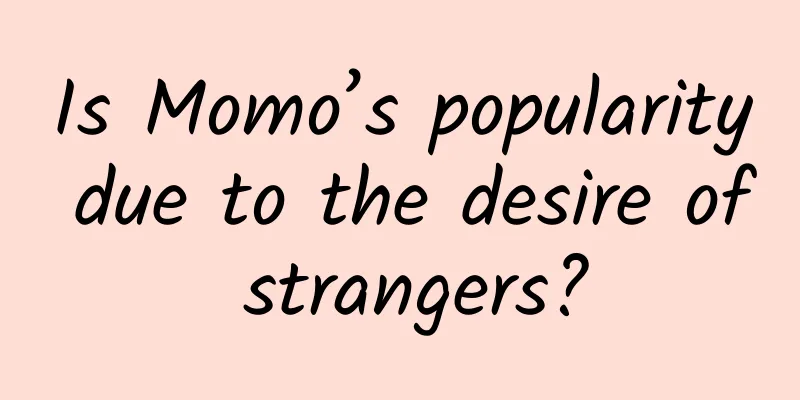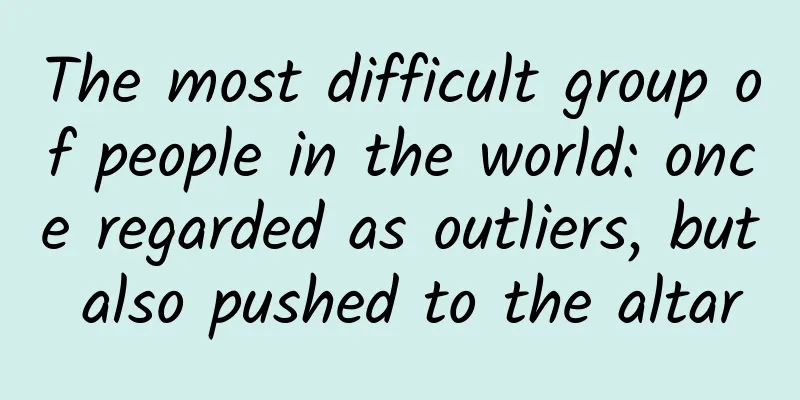Is Momo’s popularity due to the desire of strangers?

|
It is rare for a small company to attract as much attention as Momo . It was two days ago that Tang Yan and his son pressed the opening bell button, and various jokes about Momo are still circulating. In contrast, the life cycle of news in the Internet era is often only 2 hours. In the early morning of December 12, Beijing time, Momo ( Nasdaq stock code: MOMO) was listed on Nasdaq. At first glance, Momo doesn't have any flaws. The company was founded just three years ago and is still losing money. Its prospectus disclosed that its net losses in 2012, 2013 and the first half of 2014 were $ 3.8 million , $9.3 million and $8.3 million respectively. Momo was issued at $13.50 per American Depositary Receipt (ADS), and the financing scale of $216 million is not exaggerated. On the same day, the P2P platform Lending Club also landed on the New York Stock Exchange and raised $870 million. The problem with it is that the image of "a tool for hooking up" has been deeply rooted in people's minds. In the prospectus, this image was disclosed to investors as a risk warning: people my not understand the value of our platform, and there may be a misperception that Momo is used solely as a tool to randomly meet or date strangers. In fact, it is more directly called a "tool for hooking up." This is the most extreme definition of this mobile social software. Although Momo's self-definition is much broader, it says that it is "finding and discovering the happiness and entertainment around users", and users can use Momo to find nearby friends they want to make friends with, activities they want to participate in, or interest groups. They have also repeatedly denied that they have intentionally or unintentionally done "lower body" marketing. When asked why he started Momo, Tang Yan said in an interview with the media: I think communicating with suitable strangers is a basic need. "For Momo users in first- and second-tier cities, the social relationships within colleagues and industry circles are not enough. They need social interactions with strangers." In this topic system, the basis for the emergence of Momo is the existence of "Beijing Drifters". China's huge floating population is considered to be the social basis for the emergence and popularity of Momo. No one has done a deep study on this, but there is indeed a fit between the distribution of Momo's registered users and active users and the distribution of China's floating population. This may not be considered a coincidence. I have heard this version of the dream of Momo: suppose you live in Beijing, and one day when you are cooking, you find that you have run out of soy sauce. It is not realistic to run to the store downstairs or even the supermarket outside the community to buy some. At this time, open Momo and borrow some from other residents in the neighboring residential building or even on the same floor. At this time, the value of Momo is reflected. This app has a distance indicator that can show the distance between the two parties. "Just like in my hometown", residents on the same street know each other, and neighbors love and help each other. However, in big cities like Beijing, life is very different from traditional Chinese villages or even small towns: the relationship between strangers from all over the country may only be living in the same building, and they know each other but never interact with each other. What Momo wanted to do at first was to graft the warm and affectionate interpersonal relationships of "hometown" into urban life. People need to live in a place that they are familiar with and think is safe, and understanding the people around them is a foundation. Tang Yan, the founder of Momo, is from Loudi and came to Beijing in 2002. Loudi is a prefecture-level city in the heart of Hunan Province, with a total population of 4.35 million in 2011. Only four years earlier, in 1998, China lifted some restrictions on domestic population mobility, and the population began to move on a large scale. For 40 years before 1998, Chinese people were restricted to their registered residences, and it was not just a plot in movies and TV series that they needed a certificate to travel far away and a letter of introduction to stay in a hotel. Tang Yan is just one of the migrants who have moved from a small town to a big city. The "China Migrant Population Development Report 2014" released on November 18 this year shows that the total number of migrants in the country is now 245 million, more than 1/6 of the total population. In Beijing alone, by the end of 2013, among the 21.148 million permanent residents, 8.027 million were migrants, accounting for 38% of the total. These more than 8 million foreigners no longer have their previous network of relationships in Beijing, and they need to re-establish personal connections. At the same time, the anxiety of re-positioning their identities and integrating into the city will also strengthen their desire for social communication and interaction. This is not just a personal guess. The "China Migrant Population Social Integration Index and Research Report " released in September 2013 shows that migrant populations can survive and gain a foothold in the destination, but the level of social acceptance and identity recognition is relatively low. This demand has become more prominent as the speed of population influx accelerates. According to data from the Beijing Municipal Bureau of Statistics, the number of permanent migrant population in Beijing increased by nearly 4.8 million in the 10 years from 2004 to 2013. The emergence of mobile Internet has created new opportunities for Momo and others. According to data from market research institutions, there were approximately 375 million mobile Internet users in China in 2011, and this number reached 556 million in 2013. Currently, mobile social startups targeting strangers are emerging one after another. Industry insiders say that there are no less than 100 products that dominate stranger social networking in China. Among them, Momo is far ahead. In the past three years, 180.3 million people have registered on Momo, and as of now, more than 60 million people are using Momo frequently. This means that 1.3 out of every 10 people in China are Momo users; and the number of active users of this app is equivalent to the total population of China's four first-tier cities: Beijing, Shanghai, Guangzhou, and Shenzhen. According to the data from 2013, the eastern region accounted for 90.5% of the cross-provincial population inflow, and Guangdong alone accounted for 27.5% of the total. The megacities such as Beijing and Shanghai have the fastest growth in permanent population. This coincides with the distribution of Momo's users. Yang Ye, vice president of Momo, said in a public occasion last year that most of its 150 million users last year were concentrated in first-tier cities and the top ten provinces in terms of GDP; 60% of active users were distributed in the top ten provinces in terms of GDP, with Guangdong accounting for the most. Among them, users aged 19 to 32 accounted for 82% of the total. But "hooking up" is like a brand on Momo's forehead, as if it is its innate nature. Just before Momo went public, a Silicon Valley headhunter said on his Weibo : He believes that Momo is a product with evil genes because it is a tool for hooking up. He believes that as an entrepreneur, Tang Yan is a person who values money above all else and has no moral values. Many of his friends hold this attitude. Based on this, he believes that after Momo goes public, it may repeat the fate of Daily Planet Brothel. Daily Planet is a high-end brothel in Melbourne, Australia. It was listed on the Australian Stock Exchange in May 2003, was suspended in 2006, and was suspended again in 2012 after resuming trading. The first major point of interest in Momo in the US market is that it is a company invested by Jack Ma . An analysis article by MarketWatch, a news website under Dow Jones, believes that Momo has the advantage of being supported by Alibaba , which will encourage investors to hold its shares. Alibaba holds about 21% of Momo's shares. At least on the first day of listing, the market did not reject Momo because of the label of "hooking up". On December 12, Momo's stock price closed at $17.02 per ADS, up 26% from the issue price. But what about the future? Although in China, the trend of population mobility will continue. With the advancement of urbanization, project officials of the United Nations Industrial Development Organization predict that China's urban population will reach one billion by 2030. As a winner of Toutiao's Qingyun Plan and Baijiahao's Bai+ Plan, the 2019 Baidu Digital Author of the Year, the Baijiahao's Most Popular Author in the Technology Field, the 2019 Sogou Technology and Culture Author, and the 2021 Baijiahao Quarterly Influential Creator, he has won many awards, including the 2013 Sohu Best Industry Media Person, the 2015 China New Media Entrepreneurship Competition Beijing Third Place, the 2015 Guangmang Experience Award, the 2015 China New Media Entrepreneurship Competition Finals Third Place, and the 2018 Baidu Dynamic Annual Powerful Celebrity. |
<<: Where should Apple go after the large-screen iPhone?
>>: The future of Google Glass: There may still be hope in the business world
Recommend
Why don’t you want to close some landing pages once you open them?
A landing page is a web page that is displayed to...
Why do pandas love bamboo? A "symbiotic partner" hidden in their bodies!
(All pictures in this issue are from the copyrigh...
How are well-known educational institutions using short videos to make famous teachers famous?
2019-2020 is a period for short video creators in...
Common activity forms and user attraction logic
There are often some popular event cases on the m...
Lithium batteries are not the way to go. Japanese and Korean companies say hydrogen fuel is the future of new energy vehicles?
The emergence of iOS and Android phones completel...
What are the channels for online promotion of educational institutions in Chengdu?
The Internet has been developed for more than 20 ...
Deeply remembering Ms. Li Pei: a true "goddess" who never succumbed to fate
Li Pei is an "idol-level" teacher at th...
High-cost-effective configuration for high-defense server rental
With the rapid development of network business, s...
Will eating persimmons on an empty stomach cause kidney stones? Will eating persimmons make anemia patients' condition worse? Pay attention to these 3 points and eat persimmons without worry →
gossip Autumn is a time for abundant harvests. Th...
4 entry points to teach you how to operate vertical products!
Today we are going to talk about vertical product...
Today’s College Entrance Examination丨The “fruits” are ahead, pick them bravely!
Today is the first day of the national college en...
Tips for creating landing pages for advertising!
This article will share with you the techniques f...
Single window day 15-20, the latest PG assistant mini game hang up wool project
Single window day 15-20, the latest PG assistant ...
Pain and numbness? Lumbar disc herniation can be relieved with a few simple movements →
Lumbar disc herniation is one of the common "...
How can brands use TikTok efficiently? Try this method!
Recently, a friend from the brand marketing depar...









